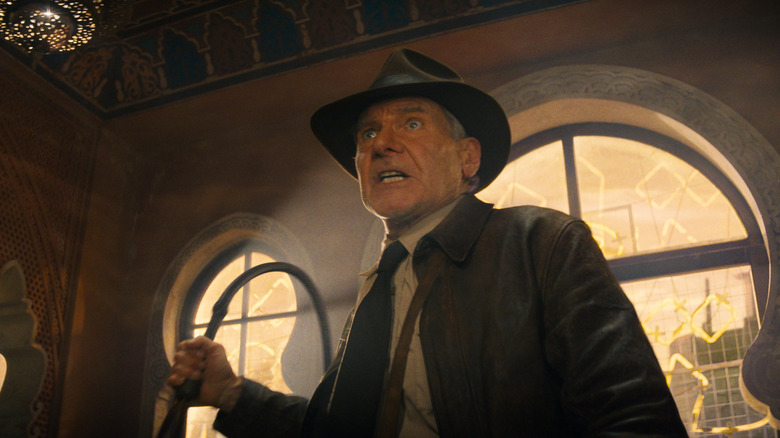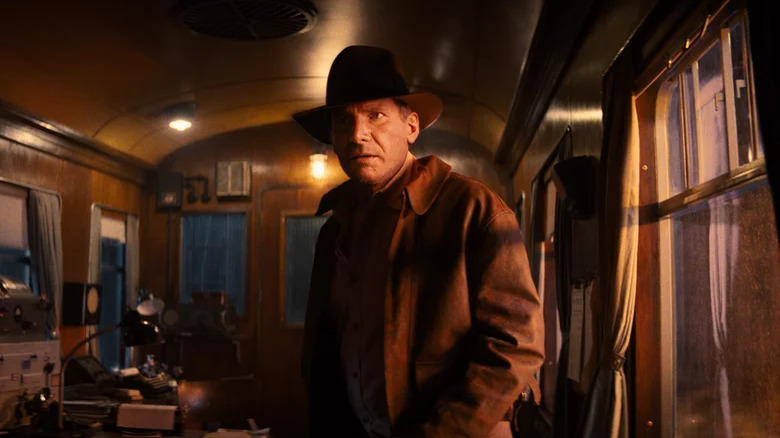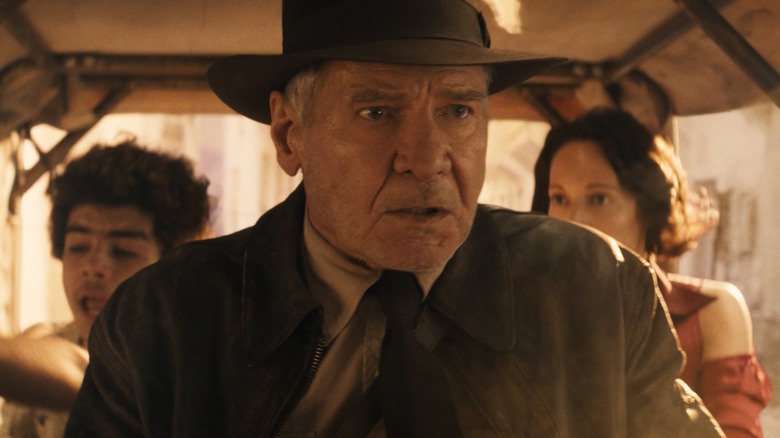How Indiana Jones Avoided The Irishman's Awkward De-Aging Problem
"The Irishman" is a phenomenal movie, one that our own Chris Evangelista called "a masterwork that finds [Martin Scorsese] reflecting on everything he's done, and what it's all amounted to." But as near perfect as that movie is, it does have some issues, and a big one is the use of de-aging technology. While it makes perfect sense in the context of the film, the technology was not perfect, and looked awkward at times, like when Frank Sheeran is beating up a shopkeeper. The de-aging made Robert De Niro's face look much younger, but the rest of his body still very much moved and felt like a guy in his 70s.
De-aging is everywhere in big Hollywood productions now, from "The Mandalorian" to "Avatar: The Way of Water" and plenty of Marvel Studios productions. The latest blockbuster to try its hand at not ruining the audience's mental picture of a beloved actor is "Indiana Jones and the Dial of Destiny," which is set to include scenes featuring a young Harrison Ford. Rather than replace him with another actor like "The Last Crusade" did, however, they're just using VFX to achieve Indy's young look.
Is this going to be another "Rogue One" situation, or worse, a Robert Zemeckis trip into the "Polar Express" uncanny valley? Longtime producer of the franchise, Frank Marshall, is confident "Indiana Jones" can pull off the impossible yet again and break the code to de-aging.
For the July 2023 issue of SFX magazine, Marshall explains that the key to de-aging Indiana Jones lies with Harrison Ford. "The key is it was Harrison acting," he said. "It's just that he was a little older when he was acting. Jim [Mangold] was able to guide him in body movement."
There may be hope yet
According to Frank Marshall, the problem with "The Irishman" is that they didn't quite have the actors' body movements down yet. That problem wasn't an issue in "Dial of Destiny," according to Marshall, because "there's so much information we have on Harrison at that age that the AI is able to make it perfect."
Granted, calling any sort of new technology "perfect" feels disingenuous, since, as Marshall himself said, the technology is always changing and always improving. That being said, the amount of information, particularly footage of actors when they're young, definitely aids the de-aging tech and allows for a more seamless process. Take the vastly underrated "Gemini Man," which de-aged Will Smith and made him look exactly as he did in his "Fresh Prince" days. That movie did not use Smith's performance, but instead created a CG character based on his performance from old projects like the aforementioned '90s sitcom.
This is exactly what Harrison Ford himself said helped "Dial of Destiny." "They've got every frame of film, either printed or unprinted, of me during 40 years of working with Lucasfilm on various stuff," he explained earlier this year. "It's bizarre and it works and it is my face."
It's a tool
If the technology is so amazing, should we expect the new "Indiana Jones" TV series to be "The Young Indiana Jones Chronicles" starring a VFX monstrosity? Not necessarily. "People ask us, is there going to be a young Indiana Jones [movie] with Harrison? No," Frank Marshall promised. "It's a tool," the producer explained, reiterating that the technology is being used sparingly in the new film.
De-aging technology can actually work — like in "Avatar: The Way of Water" where Sigourney Weaver was able to convincingly play a 14-year-old girl (albeit an alien one) — as long as the people in charge recognize when and how to use it well. But, as Marshall notes, it is important to get ahead of issues that will certainly arise. As the screen actors' guild prepares for negotiations that may lead to a strike, the question of de-aging needs to be addressed. "Certainly the actors are going to need some new kind of language in their contracts for their likenesses," Marshall added.


